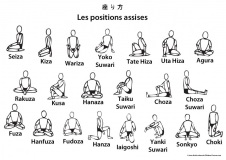Japanese: 正座
English: “sitting with a correct posture”.
Seiza is the formal way to sit in Japan. In a historical context, the correct posture is defined to have neatly-folded legs and an erect spine. One’s feet must be neatly tucked in place, underneath the body.
Sitting seiza can become painful after 30+ minutes. A technique to help with the numbing pain, is to fold the feet in an overlapping manner. In this position, the big toes are overlapping from each other while sitting down. Some say that this is a good technique in order to manage the feeling of numbness brought about by sitting in Seiza.
There is also casual, or relaxed, sitting.
Men generally sit Agura (胡座), “cross-legged” style.
The reason why the warriors in ancient Japan disliked the idea of Seiza is that the proper sitting position hinders them from quickly being able to draw their sword. Hence, it served as an unnecessary risk to their lives, and they disliked the feeling of being vulnerable and draw their sword to defend themselves. Given that fact, it was more common for ancient Japanese warriors to sit in the more relaxed position “agura”.
Agura is also presented as an alternative for foreigners, and elderly Japanese who are unable to sit seiza for a longer time (30+ minutes)
Women generall sit yoko-zuwari (横座り), “sideway sitting” (both legs folding off to one side, one side of the hips is touching the floor) or they sit wariza (), which resembles the Seiza a lot. However, the main difference is that the lower legs are bent to the side, rather than tucked neatly underneath the body.
As Japan unified and the Edo period dawned, Seiza grew even more common for people to practice. At one point, it even became common for people to practice Seize within their households using straw tatami matting, becoming the most standard sitting position. An interesting fact about Seiza is that it actually drove a Japanese behavior by which they became known for – removing one’s shoes prior to entering any room. Since the formal sitting position required the legs and feet to be folded properly, it left no provision for shoes. Hence, it became customary to remove the shoes while inside to be able to sit on top of the tatami floor.
See also: Zabuton, Agura shibari, Zazen shibari
Reference:
- https://www.way-of-the-samurai.com/Is-Seiza-a-Real-Samurai-Fighting-Position.html
- http://yabai.com/p/2761
- https://allabout-japan.com/en/article/6554/
- More…










Leave A Comment